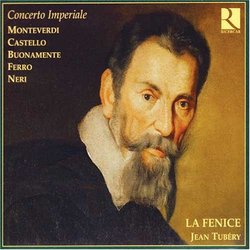| All Artists: Castello, Ferro, Neri, Buonamente Monteverdi, Jean Tubery, La Fenice Title: Concerto Imperiale Members Wishing: 0 Total Copies: 0 Label: Ricercar Original Release Date: 1/1/2005 Re-Release Date: 11/8/2005 Genres: Special Interest, Classical Styles: Opera & Classical Vocal, Chamber Music, Historical Periods, Baroque (c.1600-1750), Symphonies Number of Discs: 1 SwapaCD Credits: 1 UPC: 5400439002401 |
Search - Castello, Ferro, Neri, Buonamente Monteverdi, Jean Tubery, La Fenice :: Concerto Imperiale
 | Castello, Ferro, Neri, Buonamente Monteverdi, Jean Tubery, La Fenice Concerto Imperiale Genres: Special Interest, Classical
|
Larger Image |
CD Details |
CD ReviewsStrong performances of music from Monteverdi's world Lyle Crawford | BC, Canada | 03/18/2008 (4 out of 5 stars) "The early 17th century was a period of tremendous musical innovation and achievement in Italy, and Claudio Monteverdi (1567-1643) is certainly its best known representative. Monteverdi, like his parents, was a friend of the Austrian Hapsburgs (and was actually accused of treason to the independent Venetian Republic in which he lived and worked). He composed music for the Holy Roman Emperors Ferdinand II (crowned 1619) and Ferdinand III (crowned 1637). The instrumental Ensemble La Fenice, led by cornettist Jean Tubéry, presents a programme of music by other composers associated with the Imperial court throughout these years. The first part is music for Ferdinand II and the second part music for Ferdinand III, culminating in the programme's sole vocal work, Monteverdi's "Altri canti d'amor."
La Fenice offers a rich palette of instrumental colours: cornets, recorders, trombones, bassoon, violins, bass viol, viola da gamba, cello, archlute, harpsichord, and organ. This is in exciting contrast to some other recordings of related music with more restricted instrumentation. Concerto Palatino's Harmonia Mundi recording of Gabrieli's 1597 and 1615 canzoni, features violins, cornets, and trombones only. William Dongois' Carpe Diem intimate recordings of various all-but-forgotten early 17th century Italian composers feature Dongois' own exquisite cornet playing, but offer a smaller range of sound. The programme's first part features sonatas and other works by Priuli, a Venetian student of Gabrieli, Castello, leader of the winds under Monteverdi at St. Mark's, and Buonamente, a musician to the Imperial court in Vienna. La Fenice give balanced, even tender, performances of Priuli's Ave pulcherrima Virgo for cornets and trombones and Sonata prima in due cori, which adds violins and viols. Castello's Sonata deima terza "due soprano e doi tromboni," for two cornets and two trombones, is a virtuosic composition played with impressive control and escalating flare. Perhaps the highlight of Buonamente's Sonata a tre sopra il Ballo del grand ducca (a famous theme by Cavalieri) is the bassoon rounding out the violins and cornets before its earthy tone blends with the organ in a satisfying deep swell that concludes the first part. The second part opens with one sonata for strings and another for winds by the lutenist Ferro. Detracting somewhat from the first is an unpleasantly glassy harpsichord sound. The bassoon returns in the confident, even triumphal, second sonata, and then plays a virtuoso part in the blind harpsichordist Pesenti's short Passamezzo a due per soprano e basso, in which the recorder makes its delightful first appearance. Then we get an unusual trio of recorders, with violins, in the programme's striking final sonata by Neri, organist at St. Mark's after Monteverdi's death. Having been immersed in the musical world of the musician-emperor Ferdinand III, we finally hear Monteverdi's "Altri canti d'amor" which opens his celebrated eighth book of "madrigals of war and love" (1638) and dedicates it to "you for whom a Caesar's immortal crown of laurels / has been woven by Mars and Bellona... O great Ferdinand, the proud choir / relates in song your sublime valour." Here it must be admitted that La Fenice does fall a bit short of the standard set by Rinaldo Alessandrini and Concerto Italiano on Opus 111. Compared to the latter's expressive impact, vivid characterizations, and overall cohesiveness, La Fenice sound somewhat too breezy, laid back, and indistinct. However, this is still a worthy interpretation of this famous madrigal, as the energy that Alessandrini's group brings to it (as in their Vivaldi and Pergolesi recordings) can be almost overbearing. This offering from the Belgian early music label Ricercar is a very fine recording overall, and a chance to hear some rare and wonderful instrumental music from the time of Monteverdi. The basso continuo is (various combinations of organ, harpsichord, archlute, and viol) are restrained, maybe even understated, allowing the other instruments to shine. The cornets deserve special mention in this regard, as their tone is particularly pleasing, and nearly as fine as one hears from Dongois. The recording is generally of high quality, putting the listener close but not too close to the musicians." |

 Track Listings (11) - Disc #1
Track Listings (11) - Disc #1